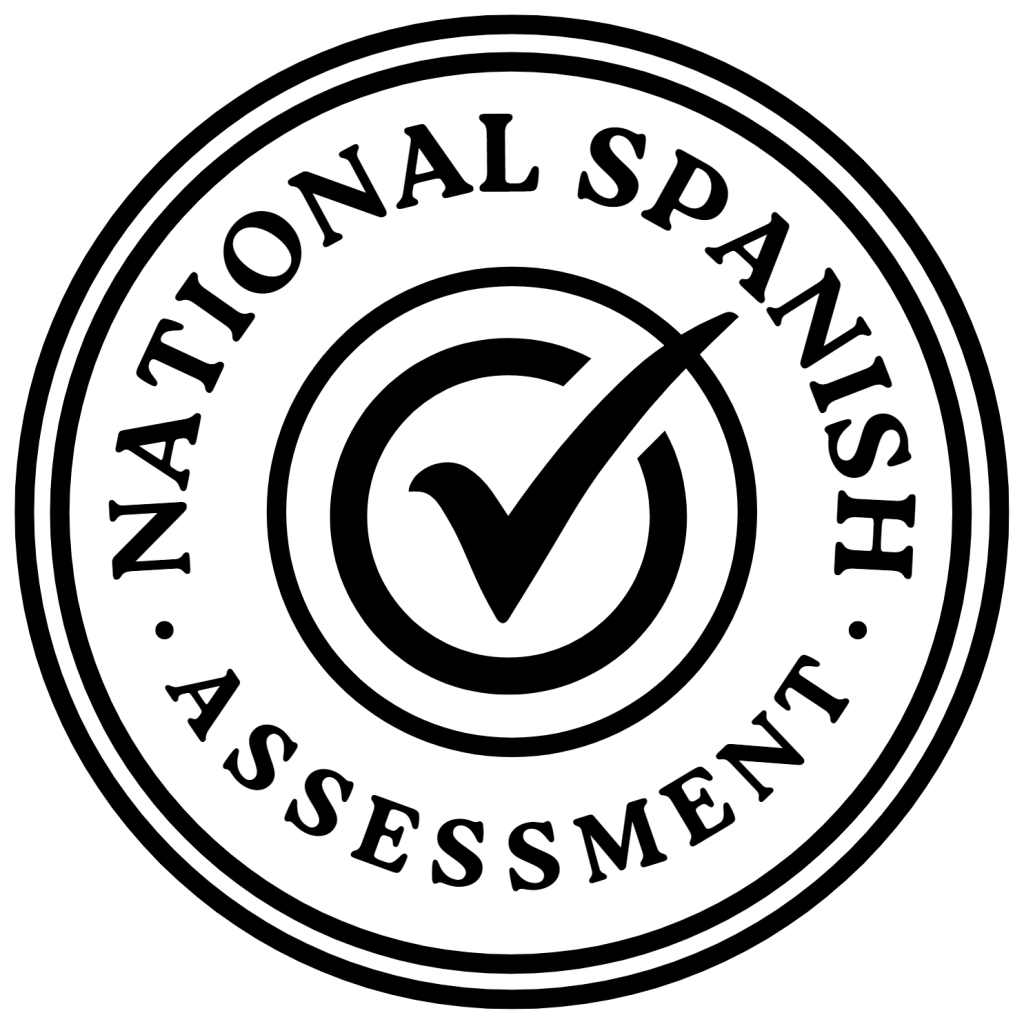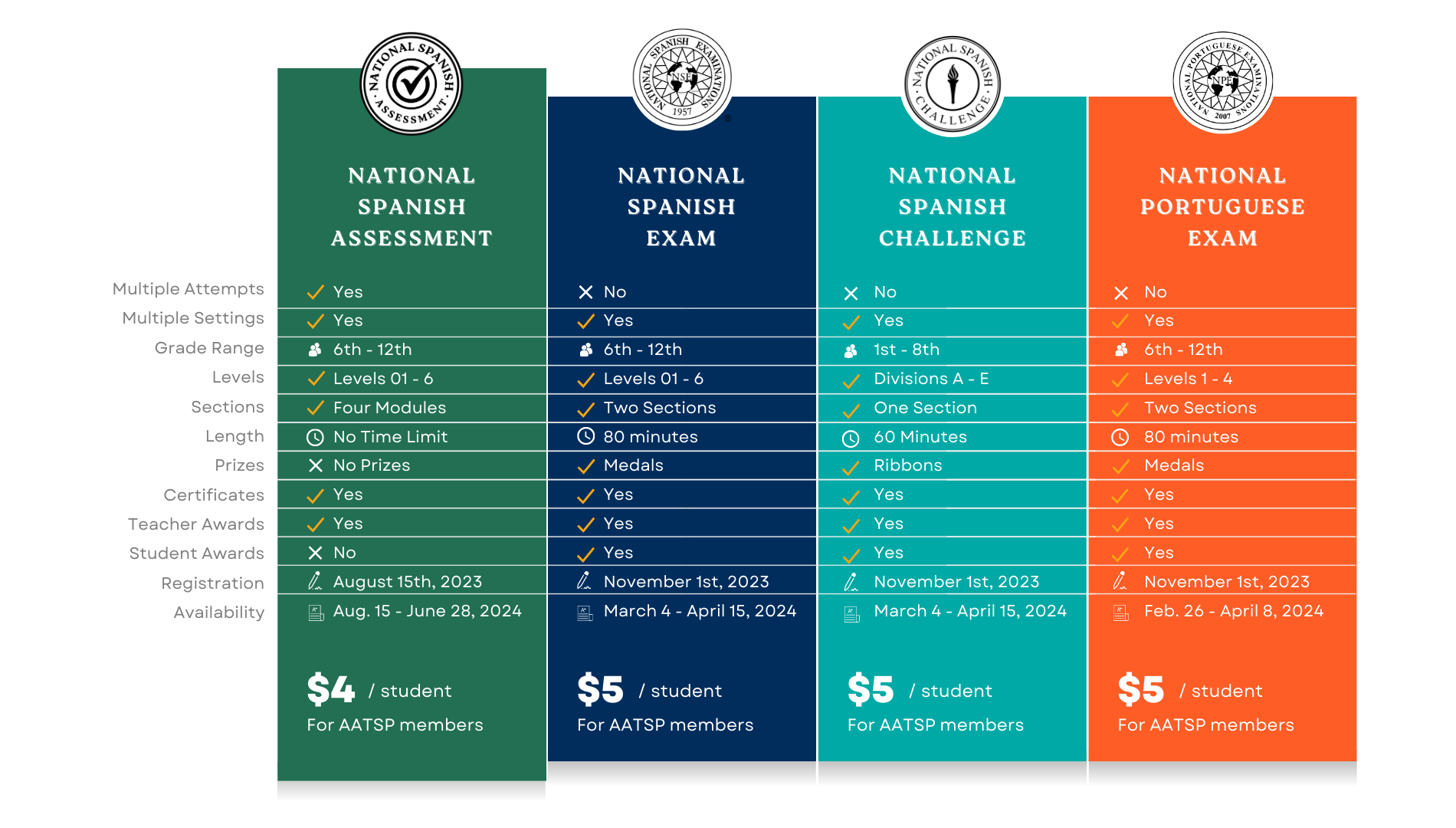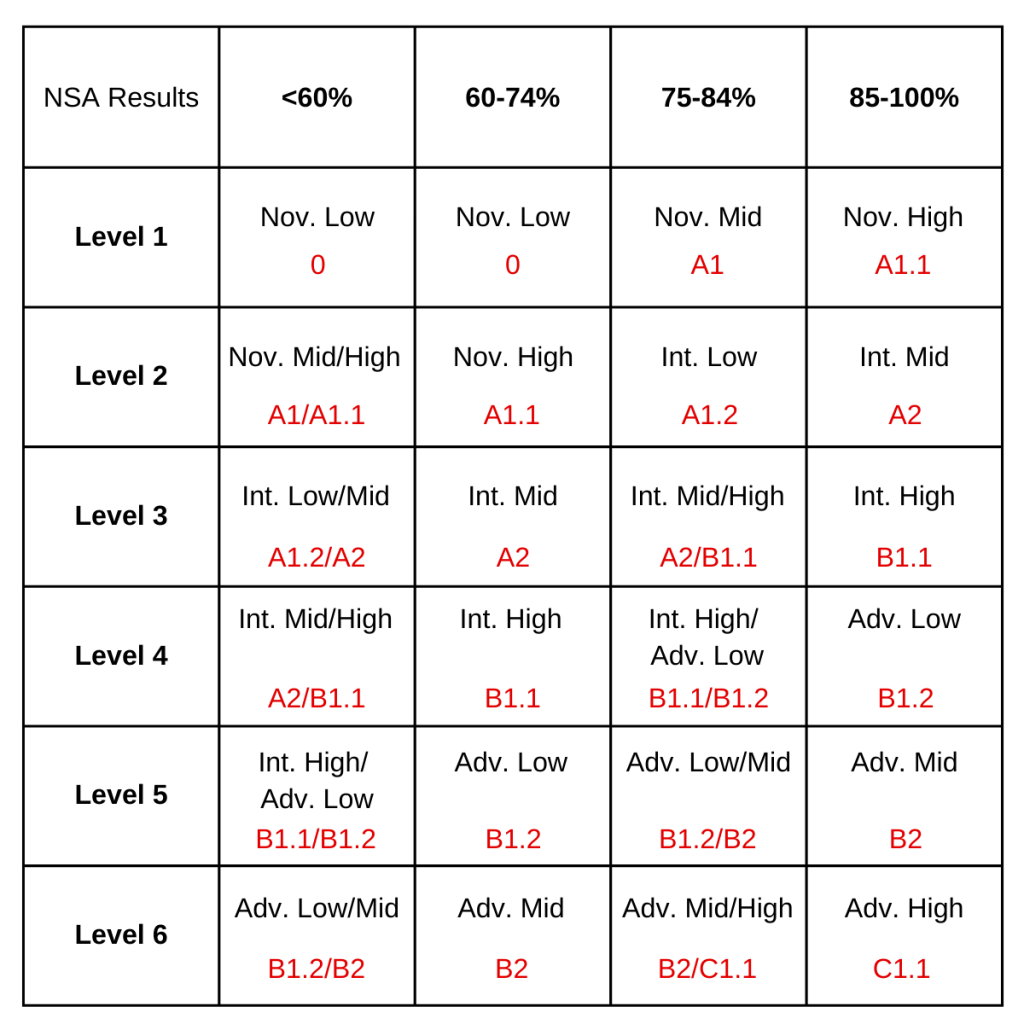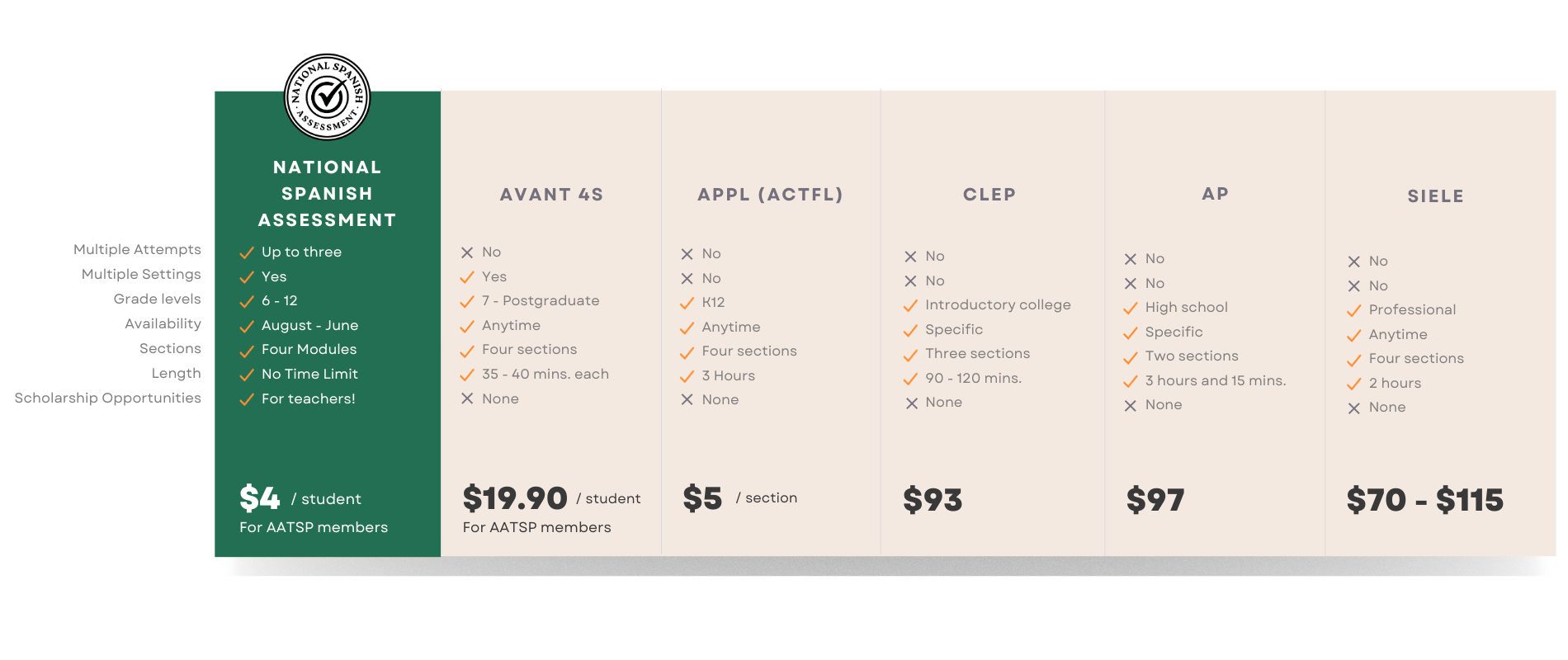NATIONAL SPANISH ASSESSMENT
Overview
The National Spanish Assessments (NSA) is an online, standardized assessment tool which tests both achievement and proficiency via computer-graded and rater-graded modules for students studying the Spanish language and is administered by AATSP Exams, a program of the American Association of Teachers of Spanish and Portuguese (AATSP).
The NSA was originally created in 2018 and is written from the same specifications and standards as the National Spanish Exam (NSE). Like the NSE, the NSA is a valid and reliable assessment of student achievement and proficiency. However, the NSA is not a competition.
Registration for the National Spanish Assessment (NSA) is now closed and will open again in August for the 2024-25 school year.
Follow our social media channels for updates!
What are the Advantages?
Join our very own AATSP Executive Director Maria Carreira in a short webinar on the advantages of the National Spanish Assessment (NSA) and its formative assessment value.

Overview
For: Middle – High School, College/University
Registration: Currently Closed
Results: Immediate
Cost Information
There are two costs associated with administering the exam: student cost and instructor cost.
Student Cost
$4.00 per student
Teacher/Instructor Cost
Giving the NSE is a benefit for AATSP Members with an active membership.
• First-Year Membership: $45
• Membership Renewal: $65
• Non-Members: $75
TOP FEATURES
About the Assessment
What’s the difference?
Flexibility is the most attractive feature of the National Spanish Assessment (NSA). The NSA is modular and allows up to three attempts throughout the school year, giving teachers the option to present material from seven different Levels (01 – 6) to their students.

HOW IT WORKS
Get to Know the Assessment
Purpose
Advantages
How it Works
Content and Format
Modules
Vocabulary
Results & Scoring
Prizes
Purpose
The purpose of the National Spanish Assessments (NSA) is:
• To promote proficiency in interpretive, presentational and interpersonal communication
• To assess the national standards as they pertain to learning Spanish
• To measure student growth during the learning process
• To provide several options for testing different skills
Advantages of the NSA
The NSA is the most flexible testing program offered in our suite of exams. Take a look at the following benefits of the NSA:
• The National Spanish Assessment (NSA) provides immediate results
• It may be administered up to three (3) times a year to show growth during the academic year
• It may be used to determine college-level proficiency ratings
• Four modules are available for teachers to administer: Reading, Grammar, Vocabulary, Listening
• Instructors may choose which of these modules they would like to administer
• Each module may be administered separately
• Levels 01-6 are available, and students are allowed to repeat Levels
• Not a national competition (ie. students are not eligible for prizes or scholarships)
• Teachers may be eligible to apply for teacher scholarships
• No late fees! Register at any time between August 15, 2023 – June 28, 2024
How It Works
Starting with a specific Level as a starting point, teachers complete their registration and invite their students to the National Spanish Assessment (NSA). Teachers have access to all of the NSA Levels, each of which include four modules, along with practice material related to the corresponding Level. Teachers have the option to test their students’ progress up to three times in the school year until the NSA window ends in late June.
Some Examples:
Take a look at some examples of how other teachers and school departments use the National Spanish Assessment:
• Growth Tracking: You decide to use only one, or two, or three, or all four of the National Spanish Assessment’s flexible modules to evaluate your students’ progress throughout the school year (year-start, mid-year, end-of-year).
• Placement: You believe that a new student will fare well in Level 2. You decide to use the first attempt to evaluate the student’s proficiency at Level 2 (placement), and then use the remaining two attempts to track the student’s growth at different levels.
• Preparation: You enter your students in the National Spanish Exam (NSE) every year. You utilize the NSA to test for placement and prepare your students for the national competition.
• Formative Value: You use the NSA in the classroom as a teaching activity, combined with a KWL chart to engage students in their own learning process.
• Independent teachers: You teach Spanish at a learning center or independently. You use the NSA to track your students’ growth and provide parents with valuable data.
• Strategic Planning: You use the National Spanish Assessment (NSA) for benchmarking, operationalizing objectives, and monitoring outcomes and successes over time.
• Summer School: You enroll your students in the National Spanish Assessment as part of your Summer School program.
• College Placement: You are a Spanish professor at the undergraduate level and use the NSA as a placement and growth tracking tool for new or first-year students.
• …and more! The National Spanish Assessment (NSA) is flexible and modular by design so that instructors can use it to suit their needs.
Exam Format & Length
The National Spanish Assessment (NSA) is a proficiency-based online exam designed to give teachers many different options and results for testing students, now available for Levels 01 – 6. Some of the content in the NSA mirrors material that can be found in past National Spanish Exams.
Level placement is at the instructor’s discretion. Students may take multiple levels if desired. Determining the appropriate assessment module to administer should be decided by the teacher and the student. Please use the following chart as a guideline:
Level 01
Recommended for entry-level beginners. The course content is equivalent to the half of the first year of middle-to-high school Spanish. (Grades 6-12)
Level 1
Students where the course content is equivalent to the second-half of 1st year high school Spanish (eg. Grade 8) or entry-level for any program where the course content is equivalent to a full year of high school Spanish. (Grades 6-12)
Level 2
Second level of high school Spanish. (Grades 7-12)
Level 3
Third level of high school Spanish. (Grades 8-12)
Level 4
Fourth level of high school Spanish. (Grades 9 – 12)
Level 5
Fifth level of high school Spanish. (Grades 10 – 12)
Level 6
Sixth level of high school Spanish. (Grades 11 – 12)
AP Language / IB-SL Students
AP Language / IB-SL
Students enrolled in a course labeled AP Language or IB-SL should be registered to take the current year’s NSE at one level higher than the course in which they were enrolled the previous year. For example, an AP Language/IB-SL student who sat for the exam at Level 4 in 2023 should be placed in Level 5 in 2024. Under no circumstance should an AP Language/IB-SL student take the NSE at lower than Level 4.
AP Literature / IB-HL Students
AP Literature / IB-HL
Students enrolled in a course labeled AP Literature or IB-HL must take the NSE at either Level 5 or 6. These students should be enrolled to take the current year’s NSE at one level higher than the course in which they were enrolled the previous year. Under no circumstance should an AP Literature/IB-HL student take the NSE at lower than Level 5.
Modules
The National Spanish Assessment (NSA) is divided into seven Levels (01 – 6).
• Each Level (01 – 6) is comprised of practice material and three Assessment attempts.
• Each Assessment attempt is comprised of four Modules.
• Each Module can be administered separately
• Teachers may choose which module(s) they wish to administer to their students
• Modules 1 – 4 can be administered three times at different points in the year to show growth.
• Each Module takes approximately 20 minutes to complete.
Computer-Graded Modules
The NSA Specific Level Exams assess content and performance standards at a specific Level. There are four modules per Level (20 minutes each):
Module 1 | Interpretive Communication – Reading Comprehension
Module 2 | Interpretive Communication – Listening Comprehension
Module 3 | Vocabulary
Module 4 | Grammar
Vocabulary Practice
Download a list of recommended NSE/NSA vocabulary words, updated for 2023-24.
Scoring
Teachers have access to raw scores and percentages once results are available.
Results
Results are available immediately. In order to have a more complete picture of the student’s language capacity, please take each student’s individual background and exposure to the language into account when utilizing the scale below. This scale is intended to provide teachers with a basis for interpretation of their student’s results using the rating guidelines from the CEFR (Common European Framework of Reference) and ACTFL (the American Council on the Teaching of Foreign Languages).

* Note: These levels do NOT necessarily correspond to course levels but rather to proficiency levels. (i.e. Level 3 ≠ Spanish III)
Certificates
Students who take the National Spanish Assessment (NSA) may be given an optional certificate of completion. Because the NSA is not a competition, students are not eligible for medals or student scholarships. Instructors who administer the NSA may be eligible to apply for a teacher scholarship.
EXPLORE YOUR OPTIONS
A Resource for Spanish Teachers
Teachers state that they use the National Spanish Assessment (NSA) to “Prepare students to take other standardized tests such as AP, IB, SAT II and college placement exams.” Administrators state that they can use data from the National Spanish Assessment to “Create reports to show how their schools have improved over an academic year.” Take a look at how the NSA compares to other exams:

TAKE THE INITIATIVE
Start the Conversation

ENHANCING OPPORTUNITIES
Information For Schools
Are you a teacher who is interested in administering one of our exams in your school? Click the button below and download our PDF conversation starter for teachers, instructors, and administrators.
EXPLORING OPPORTUNITIES
Information For Individuals
Are you a parent or student who is interested in participating in one of our exams? Click the button below and download our PDF conversation starter for parents and students.

Exam Proctors
Visit our Proctoring section for more information about use of aids, student accommodations, and more.

